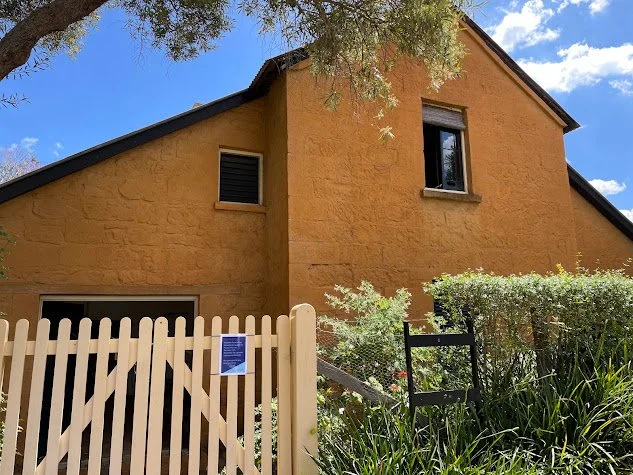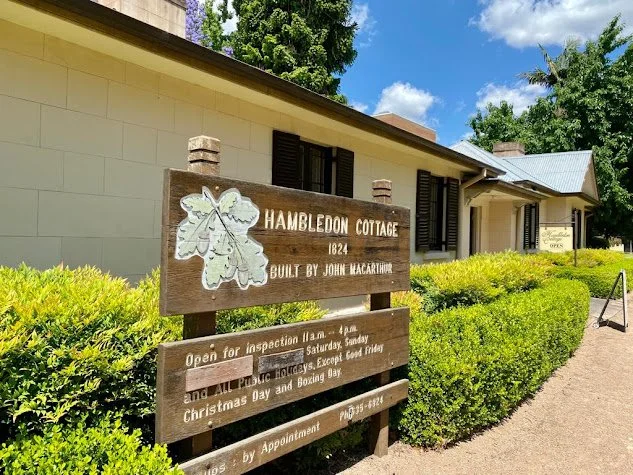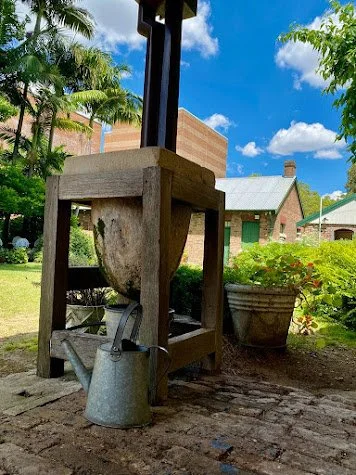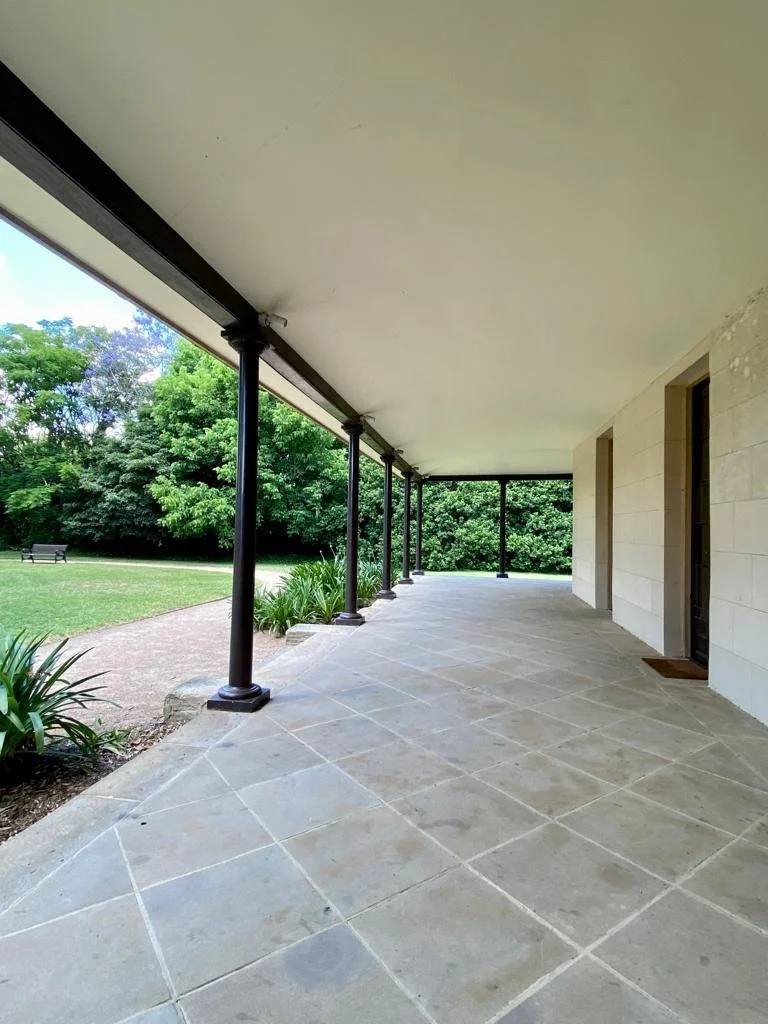Harris Park
Background
Harris Park, originally home to the Burramattagal people, was named after John Harris, doctor, magistrate, land owner and farmer. For much of the 19th century the area remained as large land holdings consisting of orchards and mixed farming including horse and cattle breeding. Significant housing was constructed during the period 1910 - 1930. In the post war period migrants came to the area from European countries, including a large Lebanese community in the 1960s. Since 1996 the demographic has changed towards an Indian community.
The first part of our day focused on colonial history via the Harris Park Heritage Walk. The second part - the food of Little India.
The historical part - Elizabeth Farm
We started our day at Elizabeth Farm, built in 1793 and one of the oldest homes in Australia, technically in the suburb of Rose Hill in Alice St. The house was built for the influential and controversial John Macarthur and his wife Elizabeth, responsible for the birth of the Australian wool industry. (He gets much of the credit, even though he was back in England for 4 and 8 years respectively. She had a sheep farming background and was the first (known) woman of education to arrive in the colony.) The cottage was a large and simple dwelling, which became an iconic example of colonial domestic architecture as it grew with various alterations and extensions.
Elizabeth lived there until her death in 1850. The Macarthur descendants sold the poorly maintained home in 1881 where it was resold and leased until the Swann family purchase in 1904. In 1968 the surviving Swanns sold to the newly formed Elizabeth Farm Museum Trust, then on to the NSW Government who opened it as a museum in 1984. Disappointingly the house was not open as per usual on the day of our trip, promotional filming was to take place (published closure on the website a week before). We wandered around the garden, which has been recreated with plants known to have been grown by the Macarthur family. The house contains recent copies of known pieces of furniture of the Macarthurs, meaning visitors can wander freely.
Hambledon Cottage
On towards Hambledon Cottage, technically in Parramatta, Hassall St and Gregory Place, where we were greeted by two delightful volunteer tour guides. We divide in to two groups to learn more about this second home owned by the Macarthurs to supplement the accommodation of family and friends. The Macarthur children’s governess, Penelope Lucas, lived there from 1827 until her death in 1836. There was no kitchen then so she returned every afternoon to Elizabeth Farm for dinner. Various family members and friends lived there until 1883, when the renamed Macarthur Cottage was subdivided and sold. Over the years changes were made to the house by the various parties who owned it. In 1965 the Parramatta & District Historical Society was given occupation of the building in return for restoring and refurbishing the interior of the building in a style of the 1830-1850 Colonial period and it was opened in February 1966 as a house museum.
The cottage contains authentic furniture from the 19th century to provide a real sense of how living in this period looked and functioned (not from the house itself, like all of us, the various owners took their furniture with them when they moved on).
An original Bunya pine tree in the garden. From little things big things grow - the cones contain the seeds from which this majestic tree grows.
Experiment Farm
Our final historical stop was to Experiment Farm, actually in Harris Park, Ruse St, which we knew was open on fortnightly weekends only. This farm was developed by James Ruse where the first wheat was sowed in Australia and the viability of the land for colonial self sufficiency was proven. John Harris, the second owner of the land, built the cottage in the form of an Indian Bungalow, a pitched thatched roof, a verandah and a raised base platform. The garden has been reconstructed from early paintings, plant catalogues and photographs. The Harris family owned the property until 1921 when the land was subdivided. It was the first property the National Trust (NSW) acquired (1961) and was restored, furnished and opened to the public in 1963.
Our Lady of Lebanon Maronite Catholic Church
We turned a corner and walked along Alice St to Our Lady of Lebanon Maronite church and school, the largest Maronite Catholic Parish in Australia. In the last 40 years the Maronite population has tripled from 10,000 to 30,000 people. The site was chosen in 1968, the hall and school opened in 1972 and the Church officially opened in 1978. A blue and white 7 metre statue of Our Lady was raised to the top of the church in 1976 and replaced with a bronze 5 metre statue in 1980 due to council and neighbour concerns and objections due to size and appearance. There is an event in the church so we stay outside.
Little India
Starting to get hungry, we headed to the Little India part of Harris Farm (with a touch of Lebanese thrown in). We kicked off with the snack Pani Puri from Jaipur Sweets. They are a ball shaped crisp bread filled with sweet potato and spices, sold 10 at a time and we were given tamarind water with a little chili to pour over them. Its a simple exercise, pour and eat quickly so the whole thing doesn’t disintegrate. It could have had more chili.
Around the corner to Billu’s Indian Eatery in Wigram St, a large airconditioned restaurant where we sat and relaxed over lunch.
Then off to La Jawab for dessert. We chose and shared a number of yummy morsels. Lots of good recommendations from the waitress!
-

La Jawab’s great display
-

-

-

To ensure we supported the other side of this multicultural suburb, we headed off to Sweetland’s Lebanese bakery across the road.
A final stop at Little India supermarket for some great priced spices and then off home. Another good day.
References
https://sydneylivingmuseums.com.au/elizabeth-farm
https://adb.anu.edu.au/biography/macarthur-elizabeth-2387
https://kategrenville.com.au/books/a-room-made-of-leaves/
https://sydneylivingmuseums.com.au/stories/turbulent-past
https://www.hambledoncottagemuseum.org.au/
https://en.wikipedia.org/wiki/Hambledon_Cottage
https://www.nationaltrust.org.au/places/experiment-farm-cottage/
https://www.olol.org.au/about-us/about-olol-church
https://www.cityofsydney.nsw.gov.au/histories-local-parks-playgrounds/history-dr-h-j-foley-rest-park
https://artout.live/glebe/hereford-street-art/
https://en.wikipedia.org/wiki/Toxteth_Park,_Glebe
https://en.wikipedia.org/wiki/Sze_Yup_Temple
https://en.wikipedia.org/wiki/Bidura




























